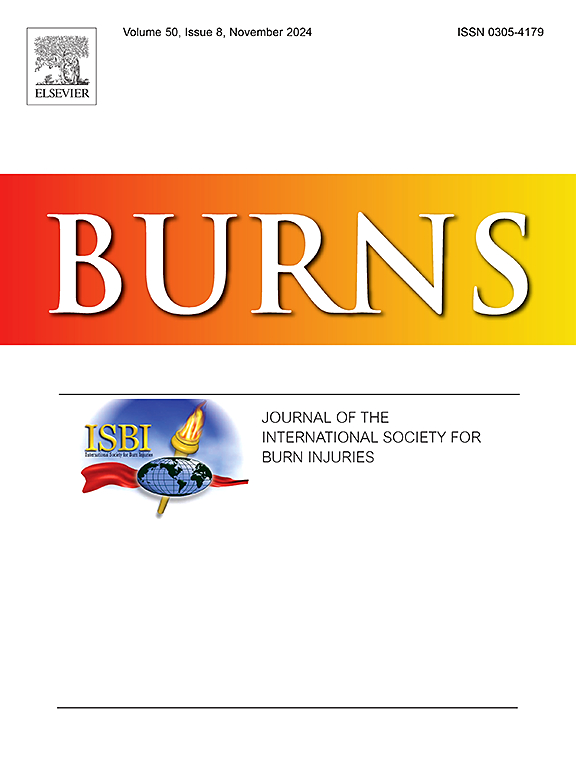The impact of decreasing acute burn re-epithelialisation time utilising Negative Pressure Wound Therapy on morbidity: A modelled, retrospective cohort study
IF 2.9
3区 医学
Q2 CRITICAL CARE MEDICINE
引用次数: 0
Abstract
Introduction
Negative pressure wound therapy (NPWT) that is applied to an acute, paediatric burn at the initial debridement may decrease re-epithelialisation time by approximately 22 %. The clinical significance of this reduction is unknown. In addition, the implication of burn variables such as depth in conjunction with NPWT have not been considered. The aim of this study was to model the effect NPWT may have on burn morbidity by reducing re-epithelialisation time by 22 % when stratified by depth.
Methods
This modelled study used retrospective data from a single Australian quaternary paediatric burns unit. Data were from 2014 – 2016, the final period before NPWT was introduced into routine, acute burn care. Burn depths were defined as superficial partial thickness (SPT), deep dermal partial thickness (DPT), and full thickness (FT). The outcome was the effect reducing time to re-epithelialisation by 22 % had on therapeutic morbidity, stratified via depth.
Results
Overall, 803 participants were included. The odds ratio of being referred to scar clinic increased by 7.6 (95 % CI 4.4 – 13.1; p < 0.001) for each incremental increase in burn depth. For DPT burns, the mean time to re-epithelialisation was 21.4 days (SE 0.7), and 134 (65.7 %) participants were referred to scar outpatient clinic. Modelled data demonstrated a 67.2 % (95 % CI 58.8 – 75.6) probability of scar outpatient clinic referral at day 21. When reducing re-epithelialisation time by 22 %, DPT burns re-epithelialised on day 16, which reduced the probability of scar outpatient clinic referral by 22.3 % (44.9 %, 95 % CI 35.6 – 54.3 %, p < 0.001). Reducing time to re-epithelialisation by 22 % had minimal impact on SPT and FT burn morbidity.
Conclusion
The addition of NPWT as an acute, paediatric burn care adjunct is likely to have a clinically significant impact on DPT burn morbidity.
利用负压伤口治疗减少急性烧伤再上皮化时间对发病率的影响:一项模拟的回顾性队列研究
负压伤口疗法(NPWT)应用于急性儿科烧伤,在最初的清创可以减少大约22% %的再上皮化时间。这种减少的临床意义尚不清楚。此外,燃烧变量的影响,如深度与NPWT的关系还没有被考虑。本研究的目的是模拟NPWT对烧伤发病率的影响,当按深度分层时,NPWT可将再上皮化时间减少22% %。方法:本模型研究使用来自澳大利亚一家第四期儿科烧伤病房的回顾性数据。数据来自2014 - 2016年,NPWT被引入常规急性烧伤护理之前的最后一段时间。烧伤深度被定义为浅表部分厚度(SPT)、深真皮部分厚度(DPT)和全厚度(FT)。结果是将再上皮化时间减少22% %对治疗发病率的影响,通过深度分层。结果共纳入803名受试者。每增加一次烧伤深度,转到疤痕诊所的优势比增加7.6(95 % CI 4.4 - 13.1; p <; 0.001)。对于DPT烧伤,再上皮化的平均时间为21.4天(SE 0.7), 134名(65.7% %)参与者被转介到疤痕门诊。建模数据显示,第21天疤痕门诊转诊的概率为67.2 %(95% % CI 58.8 - 75.6)。当再上皮化时间减少22 %时,DPT烧伤在第16天再上皮化,使疤痕门诊转诊的概率降低22.3% %(44.9 %,95 % CI 35.6 - 54.3 %,p <; 0.001)。将再上皮化时间缩短22% %对SPT和FT烧伤发病率的影响最小。结论NPWT作为急性儿科烧伤护理的辅助手段,可能对DPT烧伤的发病率有显著的临床影响。
本文章由计算机程序翻译,如有差异,请以英文原文为准。
求助全文
约1分钟内获得全文
求助全文
来源期刊

Burns
医学-皮肤病学
CiteScore
4.50
自引率
18.50%
发文量
304
审稿时长
72 days
期刊介绍:
Burns aims to foster the exchange of information among all engaged in preventing and treating the effects of burns. The journal focuses on clinical, scientific and social aspects of these injuries and covers the prevention of the injury, the epidemiology of such injuries and all aspects of treatment including development of new techniques and technologies and verification of existing ones. Regular features include clinical and scientific papers, state of the art reviews and descriptions of burn-care in practice.
Topics covered by Burns include: the effects of smoke on man and animals, their tissues and cells; the responses to and treatment of patients and animals with chemical injuries to the skin; the biological and clinical effects of cold injuries; surgical techniques which are, or may be relevant to the treatment of burned patients during the acute or reconstructive phase following injury; well controlled laboratory studies of the effectiveness of anti-microbial agents on infection and new materials on scarring and healing; inflammatory responses to injury, effectiveness of related agents and other compounds used to modify the physiological and cellular responses to the injury; experimental studies of burns and the outcome of burn wound healing; regenerative medicine concerning the skin.
 求助内容:
求助内容: 应助结果提醒方式:
应助结果提醒方式:


